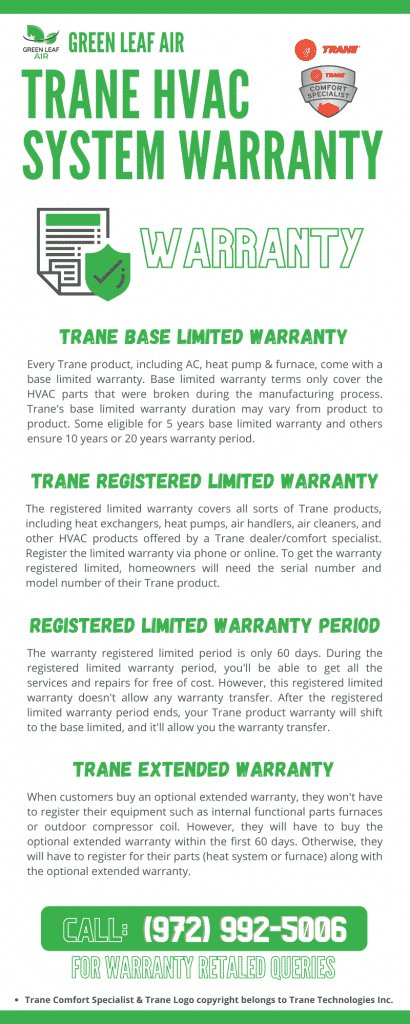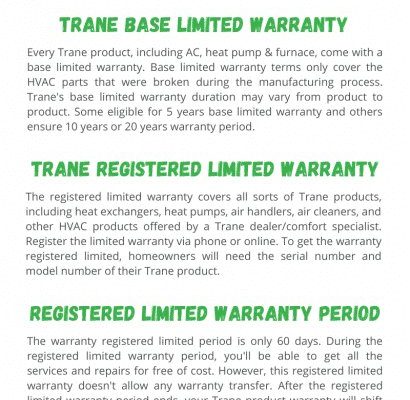
With **Trane HVAC systems**, warranties aren’t just a footnote in the manual. They’re a big part of what makes these systems worth considering. But the details can get confusing quickly—especially if you’re comparing brands, reading about different models, or trying to figure out how long your protection actually lasts. Let’s clear things up, from how the standard warranty works, to why it matters, and what’s really covered under the hood.
Understanding the Basics: What Is a Trane HVAC Warranty?
Here’s the thing: a warranty from Trane works a bit like health insurance for your home’s heating and cooling. It promises that Trane stands by its equipment—offering repair or replacement for parts that fail due to a manufacturing defect. This isn’t a “no-questions-asked” guarantee, but it’s a strong promise that you won’t be left in the lurch if something out of your control goes wrong.
Most Trane HVAC systems—whether you’re looking at central air conditioners, heat pumps, or furnaces—come with a *limited warranty* on key parts. This warranty automatically comes with your purchase. But, and it’s a big but: to get the *full* length of protection, you often have to **register your product** within a certain window after installation. Forget to register? Your warranty may be shorter.
A standard warranty doesn’t usually cover everything, though. For example:
- Labor costs (the technician’s time) are almost never included.
- Damage from poor installation, improper use, or lack of routine maintenance usually isn’t covered.
- Accessories, thermostats, and remote controls might have shorter warranty periods or separate policies.
Bottom line? The warranty is designed to cover *Trane’s* responsibility for the system—not every possible thing that could go wrong. But it’s still a big deal when it comes to long-term value.
How Long Is the Standard Trane Warranty? (And What Affects It?)
All right, you’re probably wondering: how many years do you actually get? For most new Trane HVAC systems, the **standard (registered) warranty lasts 10 years** on major parts—like the compressor, coil, and internal parts for the air handler or furnace. That’s pretty solid coverage in the HVAC world.
Here’s the catch: if you *don’t* register your system within 60 days of installation, the warranty usually drops to **5 years**. Trane really wants to know who owns the system and where it lives. Registration is simple (usually online or by mail), but a lot of folks forget—so double-check this right after your system is up and running.
Some high-end Trane models even offer longer coverage on specific parts. For example:
- Certain heat exchangers (in furnaces) can be covered for up to 20 years or even for the lifetime of the unit.
- Specific compressors may have extra-long warranties as a perk.
Still, the *standard* window most people get is that 10-year “safety net,” as long as the paperwork is handled up front. Always ask your installer for the exact terms—since the details can change depending on the year, model code, and even your location.
What’s Actually Covered Under Trane’s Warranty?
It’s easy to assume “warranty” means *everything* is protected, but that’s not quite the reality. Trane’s standard warranty focuses mainly on **defective parts**. That means if something from the factory isn’t right—like a coil that leaks or a compressor that fails unexpectedly—Trane will supply a new part at no charge.
But here’s what you might *not* realize:
- Labor is usually not covered. So, if a part fails, you’ll likely have to pay a technician to swap it out. That can sometimes cost more than the part itself.
- Routine wear-and-tear isn’t considered a defect. If your system gets clogged due to dirty filters or poor maintenance, you’re on the hook.
- Accessories—like smart thermostats or remote controls—often have a shorter warranty (sometimes just 1–5 years).
- Damage from power surges, storms, or user error is rarely included.
Honestly, the warranty is best thought of as a “parts-only” promise. It’s a real help in case of a rare defect, but not a catch-all for every issue or a free pass on neglect. Still, it’s a big vote of confidence in the code and craftsmanship of Trane’s products.
Do You Need to Register Your Trane System? Yes—Here’s Why
Let me explain: registering your Trane HVAC isn’t just busywork. It’s the secret to unlocking the full warranty period. After your system is installed, you (or your installer) have about 60 days to register the product with Trane—usually online, using the model and serial numbers.
Why does this matter? Because *unregistered systems only get the basic 5-year warranty*—not the full 10-year coverage. That’s a huge difference in protection. Trane uses registration to keep track of product performance, warranty claims, and product recalls. It’s their way of staying connected to you and your system.
If you skip registration or miss the deadline, they usually won’t make exceptions. So, take five minutes and do it as soon as your system is up and running. Keep a copy of your registration confirmation and the installation invoice somewhere safe—they’ll come in handy if you ever need to troubleshoot or make a warranty claim.
Extended Warranties: Worth Considering?
You might be wondering: is the standard Trane warranty enough, or should you pay for extra coverage? Extended warranties are like those “add-on” protections you’re offered with a new phone or TV—they can make sense, but only in certain situations.
With a **Trane HVAC system**, you can sometimes purchase an *optional extended warranty* through your installer or a third-party provider. This might stretch your coverage to 12 or 15 years, and *sometimes* includes labor costs (which aren’t covered under the standard plan).
But here’s the thing to think about:
- Most major system defects show up in the first few years—when you’re already covered by the standard warranty.
- Many service calls are for routine maintenance or user-related problems, which *no* warranty covers.
- Extended plans can get pricey, so compare the cost against the repairs you’d actually expect to need.
If peace of mind is your top priority, or if you’ve got complicated zoning, advanced remotes, or a tricky installation, an extended warranty might be worthwhile. Otherwise, the standard Trane warranty is pretty robust—especially if you register your system right away.
How Trane’s Warranty Stacks Up Against Other Brands
If you’re comparison shopping, you’ll see that **Trane’s warranty is strong, but not always the longest** in the business. For example, some brands—like Goodman or Amana—offer limited lifetime coverage on certain parts, or 10-year unit replacement guarantees. Carrier and Lennox tend to offer similar 10-year terms, but the fine print is different.
Why does this matter? Because what’s *covered* is just as important as how long it lasts. Some brands make it easier to claim warranty service, include labor, or have simpler registration. Others might have more exclusions hiding in the fine print.
When you’re deciding, think about:
- Your installer’s reputation and support—for troubleshooting, code issues, or syncing new remotes.
- How complicated your system is (more moving parts can mean more points of failure).
- Whether you need coverage for extra accessories, like smart thermostats or zoning modules.
Remember: warranty coverage is only as good as the company (and installer) standing behind it. And Trane has a solid reputation for honoring their promises.
Common Warranty Problems (And How to Avoid Them)
Nobody wants to get caught with a denied claim when the AC goes out on a hot day. Here’s what trips up most new Trane owners—and how to stay out of trouble.
- Missed Registration Deadline: As we’ve mentioned, failing to register your system on time cuts your warranty in half. Set a reminder. Do it online as soon as the installer leaves.
- Poor Installation: If the system isn’t hooked up by a licensed pro, Trane can void your warranty. DIY might save money upfront, but it’s not worth the risk in the long run.
- Lack of Maintenance: Skipping annual maintenance (like cleaning coils or changing filters) can get your claim denied. Trane expects you to take care of the basics.
- Unapproved Parts or Repairs: Only use authorized parts and service techs. Swapping in cheaper components or trying a homebrew fix is a fast way to lose coverage.
Be proactive. Keep maintenance records, your model/serial numbers handy, and all installation paperwork. If you ever need to pair a new remote, reset a code, or troubleshoot a system code, having this info makes life easier and keeps your warranty valid.
Tips for Using and Protecting Your Trane Warranty
A warranty isn’t much good if you can’t use it when you need to. Here’s how to get the most from your Trane HVAC standard warranty—and avoid headaches down the line.
Want to make your warranty work for you? Treat it like a team effort—Trane covers their end, and you look after yours.
- Register early, and double-check your confirmation email or letter.
- Stick to a regular maintenance schedule (at least once a year, ideally with a pro).
- Keep all receipts, registration records, and service reports in a safe place (a folder or digital backup works wonders).
- If you move, check if the warranty is transferable. Sometimes, this adds value when selling your home.
- If you ever have to pair a new thermostat, replace a battery, or troubleshoot an error code, use only Trane-approved remotes or parts—and keep those manuals handy!
If something goes wrong, call your installer or Trane’s customer service right away. Clear communication (and the right paperwork) is your best friend when it comes to a smooth warranty claim.
Wrapping Up: Why The Standard Trane HVAC Warranty Matters
At the end of the day, investing in a new Trane HVAC system is about comfort, convenience, and confidence. The standard warranty—10 years on major parts with registration—means you’re covered against unexpected factory defects, but it’s not a magic shield against every bump in the road. Doing your part (registering, maintaining, and using approved parts) keeps that safety net strong.
If you take the time to understand your Trane warranty, you’ll save yourself a lot of stress when those “what ifs” pop up. Honestly, it’s a small step that pays off big if you ever need to troubleshoot, repair, or just enjoy your perfectly cooled (or heated) home without worry.
